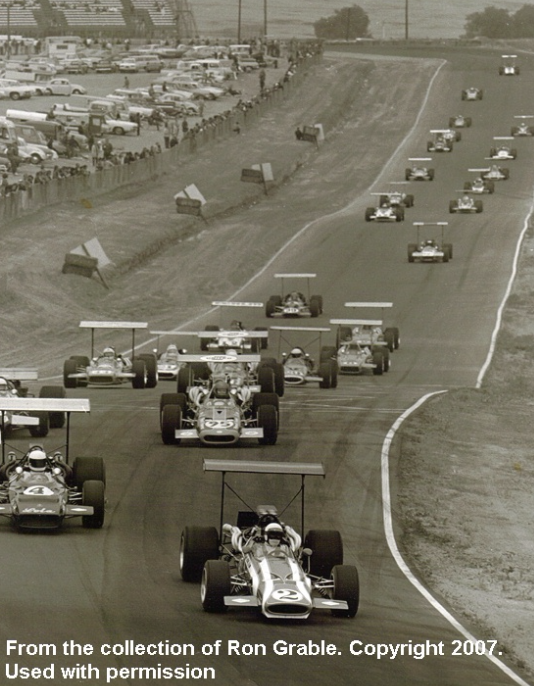
Formula 5000 Heritage
Formula 5000 (or F5000) was an auto-racing series that ran in the various countries around the world from 1968 to 1982. It was originally intended as a low-cost series aimed at open-wheel racing cars that no longer fit into any particular formula. The '5000' denomination comes from the maximum 5.0 litre engine capacity allowed in the cars, although many cars ran with 3.5, 4.5 and 4.7 litre engines. Manufacturers included greats such as McLaren, Eagle, March, Lola, Lotus, Surtees and Chevron.
North America
Formula 5000 was introduced in 1968 in the SCCA Formula A races, a series where single seaters from different origins were allowed to compete, but which became dominated by the new F5000 Cars when the large American V8s were allowed. The concept was inspired by the success of the Can-Am Series, which featured unlimited formula sports racing cars fitted with very powerful engines derived from American V8s; the idea was to replicate the concept using open wheel cars. F5000 enjoyed popularity in the early 70's in the U.S. and featured drivers such as David Hobbs, Sam Posey, Eppie Weitzes, Mario Andretti, Jody Scheckter and Brian Redman.
Increasing costs and Lola domination meant the formula quickly lost its appeal after 1975. Older cars continued to be used in the SCCA national races, but the most competitive teams reconverted their cars with sports car bodyworks, in the resurrected Can-Am championship, starting in 1977. The formula worked initially, with a number of European drivers crossing the Atlantic to attend the SCCA-run championship, but when IMSA introduced the new Group C-based GTP regulations for their own sports car championship, the old F5000 were now clumsy and slow compared to the new cars.
Europe
In the UK, the arrival of the Cosworth DFV engine meant that many teams could now afford to build their own chassis around a good engine/transmission package so Cooper, Lotus and Brabham stopped the production of customer Formula 1 cars. Unfortunately, smaller privateer teams and drivers that entered Britain's non-championship F1 events were left behind, and the RAC quickly adopted the American F5000 regulations.
Unlike the American series, the British championship didn't attract many star names from Formula 1 and sports cars, and was dominated by drivers that were usually seen in Formula 2 or in the back of F1's World Championship grids, although Peter Gethin managed to launch his F1 career thanks to his F5000 championship titles. While it was based in the United Kingdom, the British F5000 series (named Guards F5000, Rothmans F5000 or Shellsport F5000, according to the year's sponsor) managed to spread across Europe, with races held in many international circuits, including Monza (Italy), Hockenheim (Germany) and Zandvoort (Netherlands), and attracted a significant number of continental drivers.
The weak pound (a result of the energy crisis) and the increasing cost of importing Chevy V8s caused some concern and engine regulations for European F5000 were revised to permit engines other than the big pushrod V8s - the dohc Cosworth GA V6 (based on a unit used in Group 2 Capris was permitted to race at a capacity of 3500cc (rumours of a 4.0l sohc BMW also persisted, but no such engine was ever seen). March 75A and (particularly) Chevron B30 cars were successful with the V6, the March in particular being little more than a 751 Formula One car with minor modifications for the new engine.
However, the same problem that befell US F5000 happened in Europe, and in 1976, the Championship was opened to Formula 1 cars, forming the basis of what would become the Aurora F1 Championship. F5000 cars continued to be used, but were no longer competitive against their 3.0 litre counterparts. Older F5000 cars continued to be used in the British Sprint Championship.
Australia and New Zealand
In Australia and New Zealand, F5000 replaced the FIA Intercontinental Formula in the Tasman Series starting from 1970. The Tasman Series ran during the Formula One off season in the European winter, and in the late 1960s it had attracted the attention of the greatest names in Grand Prix racing, from locals Bruce McLaren and Jack Brabham to foreigners like Graham Hill and Jim Clark.
However, by the 1970s, the Tasman Series had become a competitive Australian/New Zealand local championship, but the more famous names were no longer taking part in the races, leaving the field to be dominated by the cream of "Down Under" drivers, racing against a few Europeans.
South Africa
In South Africa, F5000 first ran concurrently with used F1 cars.
Source: Wikipedia
Heritage
List of F5000 Champions
British F5000 Championship
1969 - Peter Gethin - McLaren M10A
1970 - Peter Gethin - McLaren M10B
1971 - Frank Gardner - Lola T192/T300
1972 - Gijs van Lennep - Surtees TS11
1973 - Teddy Pilette - Chevron B24
1974 - Bob Evans - Lola T332
1975 - Teddy Pilette - Lola T400
1976 - David Purley - Chevron B30
Source: Wikipedia
Tasman Series (F5000 years)
1970 - Graeme Lawrence - Ferrari 246T (2.5L FIA)
1971 - Graham McRae - McLaren M10B
1972 - Graham McRae - McRae GM1
1973 - Graham McRae - McRae GM1
1974 - Peter Gethin - Chevron B24
1975 - Warwick Brown - Lola T33
US Formula A/F5000
1967 - Gus Hutchison - Lotus 41 (1.6L Formula B)
1968 - Lou Sell - Eagle Mk4
1969 - Tony Adamowicz - Eagle Mk5
1970 - John Cannon - McLaren M10B
1971 - David Hobbs - McLaren M10B
1972 - Graham McRae - McRae GM1
1973 - Jody Scheckter - Trojan T101/ Lola T330
1974 - Brian Redman - Lola T332
1975 - Brian Redman - Lola T332/T400
1976 - Brian Redman - Lola T332C
_______________________________________________________________________________________________________________________